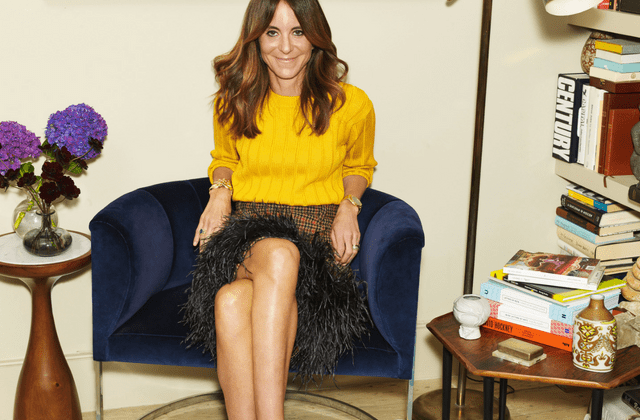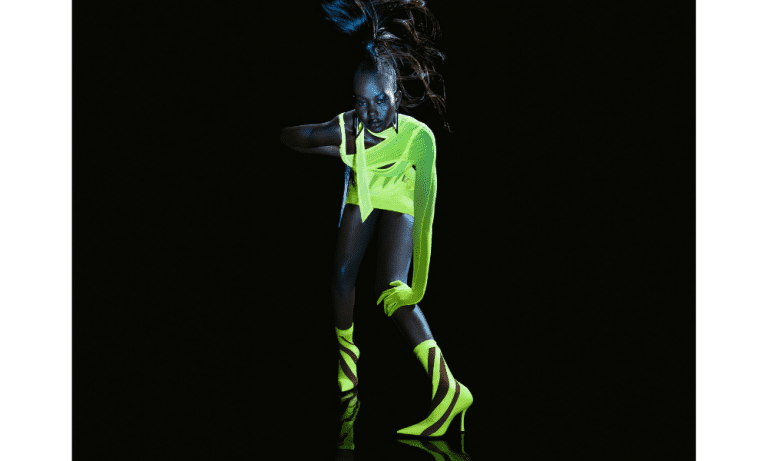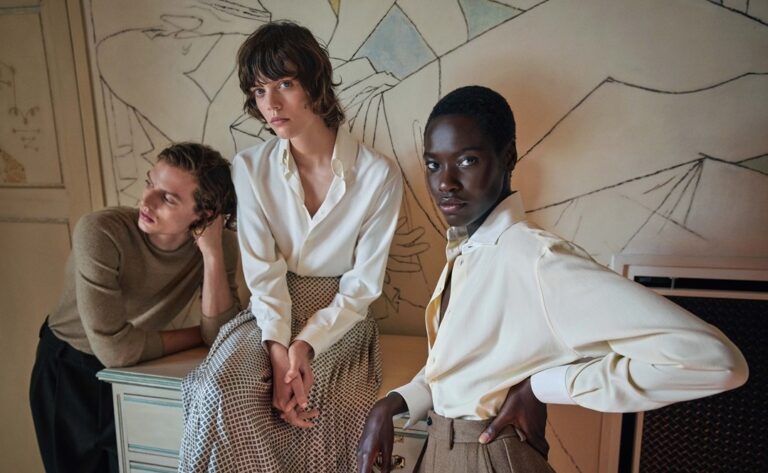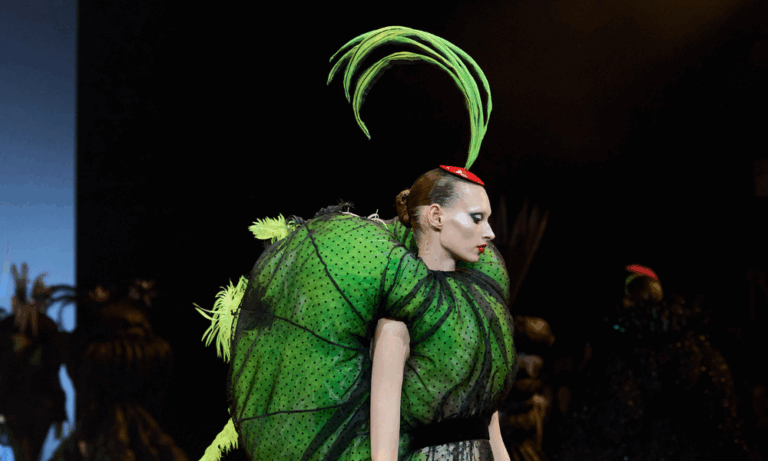TNAhe 2018 edition of Arab Luxury World took place in Dubai last week and one of the world’s most powerful women in retail, Alison Loehnis, flew into town to take part in the conference. Delivering a keynote speech on the second day of the conference to a packed auditorium, the President of Net-a-Porter and Mr Porter, delivered key insights on the Yoox Net-a-Porter Group as a whole, as well as on the profile of the Middle Eastern customer. For example, three per cent of the business’ customers are EIPs (Extremely Important People) and they make up 40 per cent of the total revenue. The Middle East represents seven per cent of the overall business and a whopping 12 per cent of the customers here are EIPs. The purchasing habits differ across the region, too, with Net-a-Porter’s (or Net or NAP as it’s known by fashion insiders) Emirati customer buying more heavily into dresses whilst the Kuwaitis are more trend-driven and love embellishment and the Saudis love glamour and jewellery.
The undisputed talking point of the day, we caught up with Alison — who, despite her position in the lofty heights of the fashion world, is someone you could easily spend a day laughing and talking with — after her presentation to discuss how the business has evolved in her almost 11-year tenure, how Net-a-Porter stays ahead of the curve and why you should never underestimate the power of a list…
You’ve been with Net-a-Porter since 2007. How has the business evolved over the past decade?
Exponentially would be the one word I’d use. When I joined the business we were probably around 100 or so people and then swiftly it got to the point where you probably didn’t know everyone’s name but you kind of did and then it got to the point where you got into the elevator and you were like, actually I don’t know everyone in here! So [there’s been a] huge amount of growth, lots of expansion, as I mentioned in my talk this morning we have been global since day one but actually seeing markets pick up on that, particularly here. There was always an appetite from the customer here for shopping online, there was a huge appetite for fashion, new brands and trends but seeing that gather pace has been incredibly exciting.
And then of course launching the new businesses. It was so funny when we started calling ourselves a group because we were one brand, Net-a-Porter, and then The Outnet and two does not make a group (laughs) and then we launched Mr Porter and we were like, we’re a group now! The Net-a-Porter group. And then we went through the merger. The way I describe it to people is that no year is ever the same and the business is constantly evolving. Off the back of the merger we became that much bigger and we took up that much more market share and it was so interesting understanding on both sides, how the Yoox team had grown so fast, what they were really strong at and how we had grown so fast and actually understanding that those two things were so complementary.
The purchasing habits differ across the region, too, with Net-a-Porter’s (or Net or Nap as it’s known by fashion insiders) Emirati customer buying more heavily into dresses whilst the Kuwaitis are more trend-driven and love embellishment and the Saudis love glamour and jewellery.
It was interesting that you noted in your talk that Yoox and Net-a-Porter actually both launched in 2000 and 18 years later you’re this one super unit of retail…
I know. It is also, as I said, our industry. Luxury fashion, they were not running to get online and frankly there are still brands out there that aren’t running to get online.
Who is the one brand you really want online?
The brand that I would want is the brand doesn’t wholesale. Hermès.
NAP is a leader in the luxury e-tail space — how do you ensure you’re constantly predicting what consumers will want next?
It comes down to, you used the word, it comes down to the customer. If nothing else, I hope my little talk this morning highlighted how unbelievably customer centric we are. That from the wonderful guy who’s delivering stuff to the person answering the phone to the person taking a picture of a product to someone writing about a product to someone packing at the distribution centre to paying someone in finance — everyone is thinking about the customer. That might sound a bit pat but there are businesses that lose sight of that and get caught up in gimmicks. I wanted to make the point about technology because technology for us is not a gimmick enabler; it’s always about doing something to make the customer’s life better. The best example that I can think of is that in 2009, shortly after the launch of the iPhone when apps were the rage, I remember going to a mobile conference and seeing a brand talk about their app and on a big screen they showed a sneaker and how you could change the colour of the sneaker. I thought, Ok well, that’s cool… what else? Can you buy it? No. So for us, this whole app craze was happening and we were hearing on a parallel track from our customers that were at their desks who would say to us, ‘I really love when you guys have new product on the site, I love seeing things that are new but if I’m not at my desk, I miss out’ and we then thought, could this new thing called an app [work to fix this]? How do we join the dots? So a bunch of our super clever developers went home for the night and came back and then our very first app was created called ‘What’s New.’ I’m not saying it was the sexiest thing in the western hemisphere (laughs) but there was this idea that was using technology to bring the store to the customer as opposed to doing something that was solely a marketing vehicle.
And that allows people the mobility to shop wherever they are…
Yeah and for us, coming back again to this genesis of our app, if we really see our job as bringing our store to the customer we need to deliver on that, right? So when we were brainstorming, and this was years ago, and we were saying wouldn’t it be amazing if you could be in the back of a taxi and shopping? Or what if you could be waiting in the customs queue, where I know you’re not supposed to be on your phone, but you’re not talking you’re shopping! We noticed it even amongst ourselves. One of the most fabulous things about working with so many amazingly talented people you’re surrounded by this focus group at all times. These people are super engaged in fashion and I love it when groups of us will be together and they’ll shop off each other.
That’s a particularly big trend amongst millennial consumers too, to see something they love, find it and buy it then and there…
Yes and that’s why our R&D team has been working on what I’m calling Fashion Shazam — it’s not going to be called Fashion Shazam so the trademark people can relax! (laughs). So this idea of [providing that service] but making sure we do it in a sophisticated way. I think for our customer there’s a certain level of specificity that she requires, as opposed to looky-likey so that’s where you have to get quite sophisticated in terms of what the solution is going to be.
There’s so much talk about brick-and-mortar stores versus e-commerce and omnichannel offerings… Does Net-a-Porter feel any pressure in that sense or do you feel like you’ve got everything you need in the online space?
The short answer is that no, we don’t feel pressure. I think we do a lot of activity offline to complement our offer so that can be anything from events to several times a year we put together style suites for our customers and also for the press to show the trends we believe in for the season, pieces we’re loving, and we invite customers in, our EIPs in. We always have physical components to our brand outreach but in terms of whether we feel pressure to open up a store, no. I think stores are wonderful but bricks-and-mortar stores are not our business.
Now to the deal that was signed with Mohammad Alabbar in 2016 — what did that mean for Net-a-Porter?
What it does for us is it really gives us amazing know-how into the market and knowledge. There’s no business with deeper roots into the luxury business here, or business here full stop, and into the customer base [than Symphony Investments].
How are the plans coming along for that?
We’ve got an office here, we have small teams across personal shopping, marketing, customer care, operations and a local CEO. Yoox and The Outnet are the first that will be fully localised and then Net-a-Porter and Mr Porter will be on the ground at the end of 2019. We’ll have same day delivery service, our own vans, we’ll be translated, we’ll have local payment systems so for our customer it’s only going to get better. And for people that aren’t customers, there’s no excuse not to try us (laughs).
So there’ll be a local distribution centre that is part of that?
Yes and that’s here already but it’s not up and running for Net-a-Porter and Mr Porter just yet.
In the Middle East we’ll have same day delivery service, our own vans, we’ll be translated, we’ll have local payment systems so for our customer it’s only going to get better. And for people that aren’t customers, there’s no excuse not to try us!
I know Net-a-Porter recently introduced a collective of capsule collections from contemporary designers — how do these designers fit into the luxury profile of the business?
They’re not mutually exclusive. Contemporary, depending on what region you’re in, can have different connotations — if you think about it in an American sense it means something different to the European sense. But when we look at how our customer is shopping and how our EIP is shopping, she wants new and to know the best of the best and wants to be at the forefront of discovery.
So that doesn’t necessarily have to be top-tier traditional luxury brands?
Not at all. I think it’s all about thinking if this product is something the customer hasn’t seen before. In terms of our assortment, is it doing a different job than everything else we have? Is it filling a customer need? If I look at how our EIPs are shopping, of course she’s buying Chloé, Dolce, Balenciaga but she’s also buying a lot into lower priced casual brands to complement the higher end offering.
Does this contemporary collective draw in a younger consumer or does it appeal to everyone?
It absolutely does but I would say that equally our more established customer is buying it as well.
So in essence it almost acts as an entry-level option into the Net-a-Porter buy…
Exactly. In the same way that beauty does. The take up on beauty is incredibly high amongst our top customers but equally it’s bringing in a younger consumer as well.
In terms of the brands that do well in the region, who are they buying most of here?
It’s basically like a roll call of the hottest brands. It’s Balenciaga, Fendi, Gucci, Chloé but also they also love eveningwear so Oscar [de la Renta] skews really highly, Reem Acra too. Whereas the menswear customer is more casual. He’s buying Tom Ford, Cucinelli and Lora Piano but he loves Common Projects. For me it was fascinating to see how the menswear customer is buying sneakers and casual trousers and our women’s customer is evening.
Dana Gers [Global Marketing & Communications Director]: There’s some surprising ones too. We have some very edgy fashion customers in the region, too, people who are buying Rick Owens and Ann Demeulemeester. They’re very well-informed fashion customers.
Alison: I think also, thanks to the Internet, the world is incredibly small and the sense of discovery is at your fingertips but equally our customer is travelling all the time. On average she’s taking 12 trips a year so she sees what’s out there and she’s super savvy.
Where does the majority of the spend come from in the region?
It’s the UAE and KSA together.
How would you describe the Mr Porter customer in the Middle East?
With the exception of being a bit more casual, I’d say he’s quite similar to the global Mr Porter customer in that he loves content and the content really helps bring the product to life. I find that our menswear customer overall likes to learn a bit about the provenance of a product — how is it made etc. They love a how. There was a time when the most popular video on Mr Porter was ‘How to tie a bowtie.’ He likes discovery, but also likes discovery in the context of what he already knows.
Do you find that the male customers are coming to the site for education in a sense in that they know what they want but they maybe don’t know the scope of that entirely?
Yes, absolutely. This isn’t to say that there isn’t a trend-driven Mr Porter customer because there is but I think my differentiation — Net-a-Porter is fashion, Mr Porter is style — is that we tend to skew more lifestyle-y, even in the product assortment. I’m quite strict with the Net-a-Porter team about sticking to fashion, beauty and accessories whereas on men’s we have more products for the home, a few more lifestyle products.
Products that fit in with their overall lifestyle vibe.
Exactly and what we found after a few years — Mr Porter in and of itself almost became an adjective. We’d say, ‘Oh my gosh, that’s so Mr Porter’ (laughs) and it lended itself so well to its own brand which is why we launched Mr P last year.
It does really well. I know I am banging on about gaps in the market but we really hadn’t found in the menswear world a brand that on the one hand offered denim, great footwear, tailoring, knitwear, sportswear, all under one umbrella at a certain similar-ish price point as well.
In regards to gender spend Net-a-Porter and Mr Porter, do you find that one gender is more readily interested in purchasing luxury online? I’m assuming it’s the females…
Yes. I’d like to say that’s down to the fact that Net-a-Porter is more established and has been around longer, 2000 versus 2011, but… Our menswear consumer loves newness but he’s less beholden to it whereas our womenswear customer was new, new, new, new, new. We can even see those spikes in products. Our sell-through on new products is incredibly high [on Net-a-Porter] and on Mr Porter it’s high as well but it doesn’t work in quite the same way.
For me it was fascinating to see how the Middle Eastern menswear customer is buying sneakers and casual trousers and our local women’s customer is buying evening.
That comes back to what you said in the talk earlier that women will shop because they feel like don’t own anything. I know myself that every time I go on a holiday I’ll buy an entirely new wardrobe…
Yes and I think Jet-a-Porter, cute name aside, was really important to us — we have a holiday offer year round, we have a ski offer year round. Wherever you’re going, wherever you are in the world, we’ve got something for you. So if you’re going some place where you’re going to be freezing in August, we’ve got something for that and equally if you’re going some place in February where you’re going to be boiling, we’ve got something for you too, in a considered way as opposed to just three swimsuits…
That makes sense when you have such a global consumer and ones who are constantly travelling, you need to be able to provide them with options.
Yeah and there’s also air-conditioning. I don’t need to tell you that (laughs).
Recently you were named as one of the most powerful women in fashion, how does that make you feel when you get those kind of accolades?
Well, first of all it’s not a one woman show. Humble would be the first word but I am surrounded by an amazing, talented team and I think one of the many things that sets our business apart is the team dynamic that exists. It’s a hugely collaborative business and of course, everyone has a specific role and specific responsibilities, but actually that sense of camaraderie and working towards a common goal is so important.
What struck me from your presentation earlier was the story you told about one of the delivery drivers who had starting waiting for customers to try on their purchases before he left in case they wanted to return anything which then inspired the “You Try, We Wait” option — that signifies an important level of collaboration across all levels of the business, it’s not just the senior executives that are coming up with ideas and that are being listened to…
Oh my gosh, yes, not at all. In fact I remember when I joined I was in one of my very first meetings in our old offices and we were looking at product photography and there was a guy there, I think he was a developer, in a heavy metal T-shirt, the works, and we were looking at a Bottega bag and he was like, “something something something and the Intriccato and the thing on the Bottega Veneta bag” and I was like, oh my gosh. Here is this guy who’s not buying the product but is super knowledgeable about what he’s selling and he’s really in tune with what the customer is going to react to. I loved it.
What advice would you give to women looking to break through to senior management and leadership roles but maybe feel like it’s an impossible task? I think fashion is maybe one of the more inclusive industries in terms of the gender divide — has that been your experience?
I’ve been lucky in that I’ve worked in businesses for the most part where women were well represented. I think, increasingly so, and from a YNAP perspective that’s really been a priority. Diversity has been a huge priority. Over more than half of our senior positions are filled by women.
In terms of advice, I have a couple of pieces of advice. The first one I would give is, which I got from my headmistress when I went to a girls school for 12 years, who three times a week at assembly would say, ‘Girls can do anything! Girls can do anything! One day there’ll be a woman president.’ And after a while that sinks in, right? So I think this notion of believing that you really can do anything, just go for it. Don’t worry about what your CV says, go for what you want.
The second piece that I think is really important is around priorities. A question I get asked a lot is how to be a working mum and my view is that your priorities are your personal business, you don’t have to share them with anyone but just be really clear on what they are. If your family comes first, know that and that helps the decision-making. Similarly, if your work comes first, know that. Just be super clear. I think when you’re grey and things are a bit fuzzy when it can be difficult. And do not be afraid of making a list (laughs).
A piece of advice I would give is to believe that you really can do anything, just go for it. Don’t worry about what your CV says, go for what you want.
So after 10 and a half years, is there one key highlight you can pick out or is it a collection of many things?
Oh there’s so many! Sending out our millionth order was incredibly exciting. Celebrating our ten years, launching The Outnet, launching Mr Porter. I remember so vividly us having a countdown to the first order. I think also, from a career development standpoint, seeing teams develop and individuals who you might hire into one position really grow and flourish in their role. We do a lot of internal promotion, that’s super satisfying. We bring in amazing talent externally too.
I think the closure of the merger and being on the Italian stock exchange was amazing. The whole Borsa was covered in a big black ribbon for Net-a-Porter and that was pretty amazing. Selling a watch for 140,000 Euros was pretty amazing, bringing on new brands, launching collaborations — there’s so many things!
I would also say seeing projects through from inception to completion. A recent example would be Fendi. Dana was with me and we we cooked up this idea and that was exactly what went live and quite often when you’re brainstorming ideas, what you think you’re going to do and what you actually end up doing are two very different things but this was to the letter… No pun intended (laughs). It was exactly what we envisioned and the sales were phenomenal. We sold out of ready-to-wear almost instantaneously.
That’s the thing about ready-to-wear, one of the things that surprises people about our business is how well we sell ready-to-wear. The assumption from the outside would be that we must sell lots of shoes and bags, which of course we do, but we’re very ready-to-wear heavy. Coming back to the customers appetite for trends and new pieces, we can sell pieces that brands can’t sell in their own stores. So we’ll sell lots of runway, lots of directional pieces and we’ll have brands say to us that they didn’t order many of a certain piece for their own store and we’re like, we’ll take it. And we sell it.
Do you think that has to do with Net-a-Porter’s reputation or the way the products are presented and styled? Or is it something else entirely?
I think it can do [in regards to styling and presentation]. I’m super proud of the styling work that the teams do. But I think though that some pieces are so distinctive that the styling won’t tone them down. You’re either going to be that customer or you’re not. You can put a marabou jacket with denim all you want but it’s still going to be a big marabou jacket.
Net-a-Porter has been so instrumental in spotting gaps in the market, is there a gap you’re currently looking at?
(Smiles) Oh yes there is! Oh yes there is. We have a secret project that will not be secret for much longer of a few little, capsule-based things we’re doing which may or may not lead to other things. And I know that’s the most annoying thing I could possibly tell you (laughs) but it’s a real passion project of mine.
Watch this space.
Now, see which cult handbag brand has just launched its debut footwear line on Net-a-Porter.




